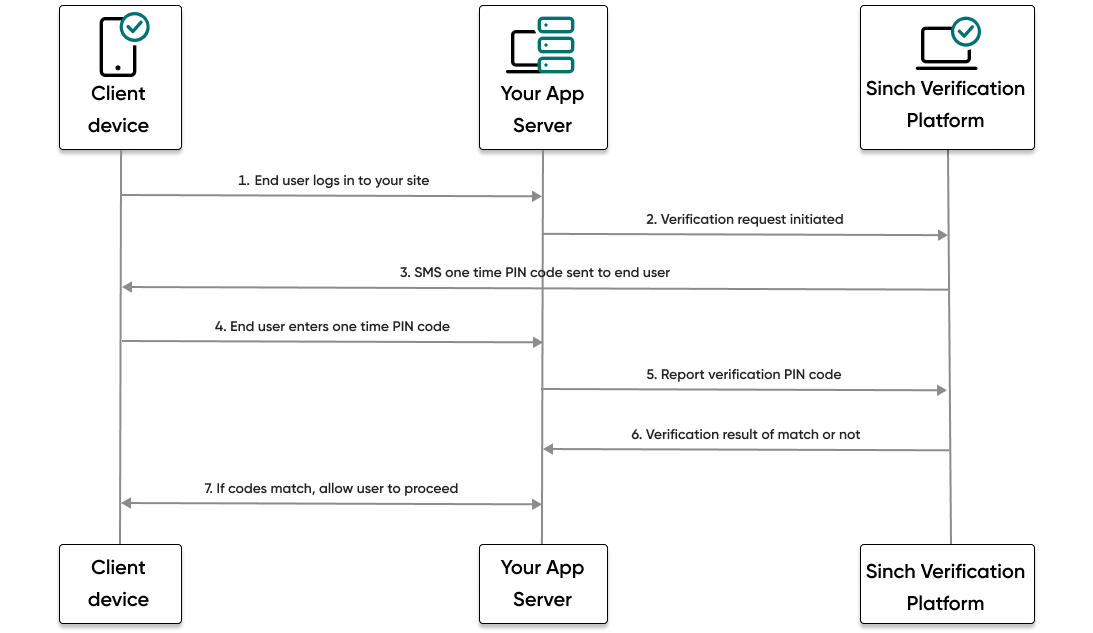Verify a user using SMS PIN with Node.js SDK
This guide shows how to verify a user in a Node.js application using the Verification API and Node.js SDK to make and then report an SMS PIN verification.
The following diagram demonstrates the flow that happens to verify a user:
- The end user visits your website or service and tries to log in.
- Your backend then makes a request to the Sinch platform and initiates an SMS PIN verification request.
- The Sinch platform sends an SMS message with a one time PIN code to the phone number of the user.
- The user enters the code they received.
- Your backend makes a report verification request using the code the user entered.
- If the code matches, your backend will receive a success result from Sinch.
- The user, now verified, can proceed to log in to your site or service.
In this guide you will learn:
What you need to know before you start
Before you can get started, you need the following already set up:
- Set all Verification API configuration settings.
- NPM and a familiarity with how to install packages.
- Node.js and a familiarity with how to create a new app.
- A mobile handset that can receive SMS messages.
Set up your Node.js application
First we'll create a Node project using npm. This creates a package.json and the core dependencies necessary to start coding.
To create the project, do the following steps:
- Create a folder called
sms-pin-verification. - Navigate into the folder you created and run the following command.This command adds the package.json file. You will be prompted to provide values for the fields. For this tutorial, you can simply accept the default values and press enter at each stage.
npm init
You can install the Sinch Node.js SDK using either NPM or Yarn:
npm install @sinch/sdk-coreyarn add @sinch/sdk-coreCreate your file
Create a new file namedindex.js in the project and paste the provided "index.js" code into the file.Modify your application
The code provided includes placeholder parameters. You'll need to update the parameters detailed in the following subsections with your values.
Initialize the client
Before initializing a client using this SDK, you'll need your application key and application secret for your Verification app, found on your dashboard.
To start using the SDK, you need to initialize the main client class with your credentials from your Sinch dashboard.
const {SinchClient} = require('@sinch/sdk-core');
const sinchClient = new SinchClient({
applicationKey: "YOUR_application_key",
applicationSecret: "YOUR_application_secret"
});Note:
For testing purposes on your local environment it's fine to use hardcoded values, but before deploying to production we strongly recommend using environment variables to store the credentials, as in the following example:
.env File
APPKEY="YOUR_application_key"
APPSECRET="YOUR_application_secret" app.js File
const {SinchClient} = require('@sinch/sdk-core');
const sinchClient = new SinchClient({
applicationKey: process.env.APPKEY,
applicationSecret: process.env.APPSECRET
});Note:
If you are using the Node.js SDK for multiple products that use different sets of authentication credentials, you can include all of the relevant credentials in the same configuration object, as in the following example:
const {SinchClient} = require('@sinch/sdk-core');
const sinchClient = new SinchClient({
projectId: "YOUR_project_id",
keyId: "YOUR_access_key",
keySecret: "YOUR_access_secret",
applicationKey: "YOUR_application_key",
applicationSecret: "YOUR_application_secret"
});Save the file.
Initiate your verification request
- Now you can execute the code and initiate your verification request. Run the following command:
node index.js - Follow the prompts in the console and enter the phone number of the mobile handset to which you want to send the SMS PIN verification request.
You should receive a text message to your mobile handset with a verification code. In a production scenario, this is the code that a user would enter into your app to verify their account.
Troubleshooting tip
If after running your app you receive a 5000 error response, you may have forgotten to save your file after adding your authentication values. This is an easy mistake to make! Try saving the file and running the app again.
You should also see the JSON response in the console.
Report your SMS PIN code
Now that you've received the SMS PIN code to your mobile handset, it's time to report that code to the Sinch servers to complete the verification process.
- In the console, follow the prompts by entering the code you received on your mobile handset.
- If you entered the code that you received, you should see a success report response in your console.
- Enter
Qin the console to quit the application or try sending a code to your mobile handset again and reporting an incorrect code to see what happens!
